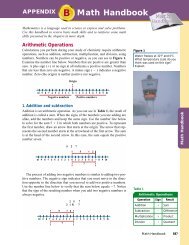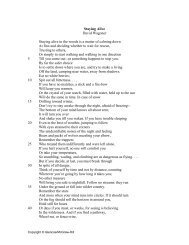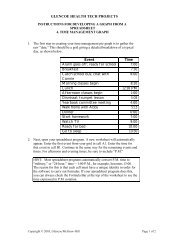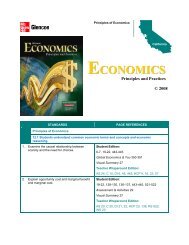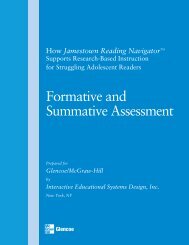Skills Practice Workbook - Glencoe
Skills Practice Workbook - Glencoe
Skills Practice Workbook - Glencoe
You also want an ePaper? Increase the reach of your titles
YUMPU automatically turns print PDFs into web optimized ePapers that Google loves.
3–4<br />
NAME DATE PERIOD<br />
<strong>Skills</strong> <strong>Practice</strong><br />
Adjacent Angles and Linear Pairs of Angles<br />
Use the terms adjacent angles, linear pair, or neither<br />
to describe angles 1 and 2 in as many ways as possible.<br />
1. 1 2<br />
2. 3.<br />
neither adjacent angles adjacent angles;<br />
linear pair<br />
4. 5. 6.<br />
1<br />
2<br />
neither adjacent angles adjacent angles<br />
7. 8. 2 9. 1<br />
1 2<br />
adjacent angles neither adjacent angles;<br />
linear pair<br />
In the figure at the right, MA �� and MG �� are opposite<br />
rays. Also, MC �� and MJ �� are opposite rays.<br />
10. Which angle forms a linear pair with �AMC?<br />
�CMG or �AMJ<br />
11. Do �CME and �EMJ form a linear pair?<br />
Justify your answer. Yes, their noncommon sides<br />
are opposite rays.<br />
1 2<br />
12. Name two angles that are adjacent to �EMG.<br />
Sample answer: �CME, �GMJ<br />
13. Name two angles that form a linear pair<br />
with �JMG.<br />
�AMJ, �CMG<br />
14. Name three angles that are adjacent to<br />
�AMK. �AMC, �KMJ, �KMG<br />
1 2<br />
1<br />
1 2<br />
© <strong>Glencoe</strong>/McGraw-Hill 15 Geometry: Concepts and Applications<br />
A<br />
K<br />
1 2<br />
2<br />
M<br />
C<br />
J<br />
G<br />
E




